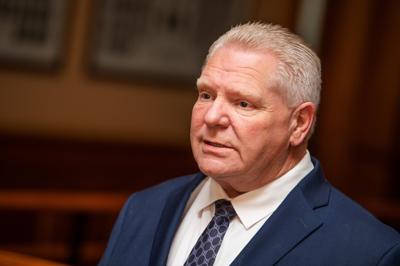We learned this week about more trouble in our halls of learning.
The big news? Ontario’s public colleges have shed more than 8,000 positions since last year’s federal clampdown on foreign visa students.
In truth, it’s predictable news. We already knew that massive layoffs and job losses were destined to devastate colleges and also universities across the province, though the latest tally is surely bracing news.
But don’t blame the federal cap on international students for the roller coaster rise and fall in revenues on campus. Remember, as educators teach their students, the difference between correlation and causality.
The root of the crisis in higher education lies with the fiscal time bomb planted by Doug Ford’s provincial government when it came to power seven full years ago this month. The latest job losses and cancelled courses were always foreseeable, because post-secondary funding remains unsustainable.
The federal restrictions on foreign students, which hit tuition revenues, are a convenient distraction — one of many that the premier is counting on to confuse Ontarians. Now, Ford’s Tories are back at it, doubling down on the same old playbook.
The seeds were planted by the premier in 2018, when he first targeted universities and colleges for financial strangulation and political interference. In 2019, the newly empowered Progressive Conservatives announced a 10 per cent cut in tuition paid by students.
Ford’s government followed up with a freeze that has remained in place ever since, year after year. But before you blame the Tories alone, take note of their political enablers.
In this year’s provincial election campaign, the opposition Liberals and New Democrats reflexively lined up behind Ford by saying they’d perpetuate the tuition freeze. That’s no way to run a province or fund higher education.
True, Ontarians are feeling stretched in uncertain economic times, and they weathered an inflationary hit post-pandemic. But this catastrophic freeze was put in place long before — for political, not economic reasons — and is destined to continue for years to come.
Consider the folly of this faux populism masquerading as affordability: No one expects the government to order landlords to cut their rents by 10 per cent and freeze them forever after (even rent control allows for inflationary increases and some costs to be passed on); in any case, landlords would be compensated for any rent reductions.
Imagine if Colleges and Universities Minister Nolan Quinn, a former Dairy Queen franchisee in Cornwall, was ordered by DQ headquarters to slash prices on Oreo Blizzards and dipped cones by 10 per cent, followed by a freeze on frozen deserts, while the cost of labour and Oreos kept climbing. Quinn and his fellow franchisees would rebel — or go out of business.
While the premier cheerfully claimed credit for the tuition slash and flash freeze, he never made colleges and universities whole. Instead, he encouraged them to exploit the market for affluent foreign students to make up the difference with higher fees.
It worked, sort of, until it didn’t.
Campuses grew increasingly dependent on the foreign cash flow, allowing ever more applicants to feed their fiscal addiction — to the point that international students became a majority at many colleges (universities were more restrained). The surge in students also applied pressure to housing markets, soaking up scarce supply and driving up rents.
When the inevitable federal curb was imposed, colleges and universities were massively exposed to the fiscal hit. But it’s about more than mere money.
Beyond the fiscal hocus-pocus, behold the ideological obsessions that are behind the government’s meddling.
Shortly after taking power as self-proclaimed populists, Ford’s Tories also took aim at student fees. Supposedly focused on affordability, it was really about political palatability.
Forcing universities to curb mandatory contributions for student newspapers or other causes was a convenient way to defund organizations deemed distasteful by the Progressive Conservatives. But student organizations fought and won in court, forcing the government to back down after the government was criticized for failing to undertake proper consultations.
Now, having learned their lesson — yet none the wiser — the Tories are going through the motions of formal consultations this time as they recycle their discredited campaign against student fees. They are also prodding the universities on their admissions criteria, demanding greater “transparency” about what constitutes merit for applicants ().
That has educators worried that Ford’s government is ready to jump on the populist, anti-diversity bandwagon embraced by the Donald Trump administration in the U.S. It may also expose the government to more court challenges.
Against that backdrop, universities say the government’s chronic underfunding will leave them unable to find spots for 80,000 worthy Ontario applicants over the next five years. At a time when the province is facing unprecedented economic upheaval from a growing trade war with the U.S. — and with Ontario pitching for foreign investment by pointing to its educated workforce — Ford’s Tories still have a few lessons to learn.
(Disclosure: I’m a Senior Fellow at the Dais at ɫɫ�� Metropolitan University, and at the Munk School of Global Affairs & Public Policy at the University of ɫɫ��.)
Error! Sorry, there was an error processing your request.
There was a problem with the recaptcha. Please try again.
You may unsubscribe at any time. By signing up, you agree to our and . This site is protected by reCAPTCHA and the Google and apply.
Want more of the latest from us? Sign up for more at our newsletter page.




























To join the conversation set a first and last name in your user profile.
Sign in or register for free to join the Conversation